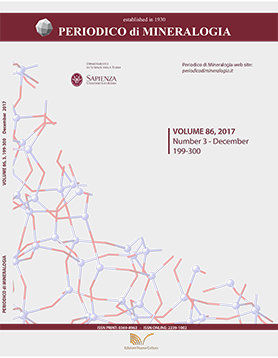Titanite-centered ocellar texture: A petrological tool to unveil the mechanism facilitating magma mixing
DOI:
https://doi.org/10.2451/2017PM727Keywords:
titanite liquid, rheological contrast, thermal equilibrium, element diffusion, back-vein, Chotanagpur Granite Gneiss ComplexAbstract
The titanite-centered ocellar texture is a rarely observed texture from magma mixing and mingling zones. This work provides a synthesis of petrographical observations and mineral-chemical data to understand the genesis of this texture. The rock with titanite ocelli is from the mafic-felsic interaction zone of the Nimchak Granite Pluton (NGP) of Chotanagpur Granite Gneiss Complex (CGGC) of Eastern India. Interpretations reveal that when mafic (basaltic) magma intrudes a crystallizing felsic (granite) magma chamber the first interaction that takes place between the two phases is diffusion of heat from the relatively hotter mafic magma to the colder felsic magma followed by diffusion of elements. When thermal equilibrium is reached between the two magmas the rheological contrasts between the two phases gets drastically reduced, allowing the felsic melt to back-vein the mafic magma. The influx of felsic melt results in breakdown of minerals like amphibole and biotite in the mafic system resulting in liquids of titanite composition. These liquids get incorporated into the incoming felsic melt as an immiscible phase and flow with it. The felsic melt and the immiscible titanite-liquid occupy the void spaces left behind by escaping gases/volatiles in the mafic system ultimately forming rounded titanite ocelli.


